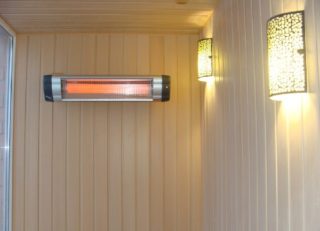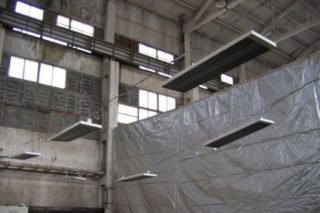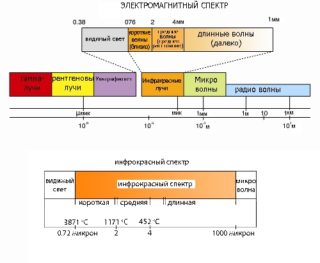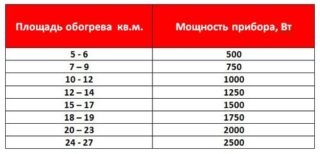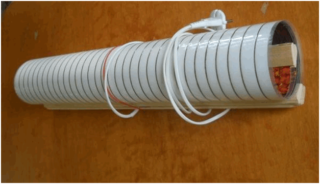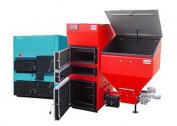To cheaply and efficiently heat a living room, a wall heater is often used. It allows you to quickly and fully emit thermal energy, which is evenly distributed throughout the room. Among the most popular and budget devices, the infrared version is distinguished.
Wall mounted infrared heater
This type of appliance differs from others in the principle of operation. When connected to the mains, the fireplace emits thermal energy, which it spends not on heating the air in the room, but on objects. The room quickly stabilizes at a comfortable temperature.
Heat radiated by the heater instantly warms up the walls and ceiling. From here, heat is transferred to the air masses. Regardless of whether the open or closed room should be heated, the heater does not waste energy in vain.
The design of the electric IR fireplace consists of important details:
- reflector;
- heater;
- emitter;
- insulator;
- body.
A special foil is provided in the reflector, which has a thickness of at least 130 microns. The insulator of the electrical appliance is made of basalt material.
In order for heating to work throughout the house, infrared heaters must be installed in each room. It is best to place the device under the window if size permits.
Advantages and disadvantages of electric wall heaters
Wall-mounted electric heater is widely used. This is due to the following advantages:
- Rapid heating of the room and maintaining the same temperature below and above.
- No noise during operation, does not emit clicks during automatic start.
- It has a long service life, works longer than the established warranty period.
- Withstands power surges, thanks to the temperature regulator it maintains an optimal microclimate.
- The equipment is suitable for use in baths, saunas and other rooms with a pronounced level of humidity.
The electric wall heater is not without negative qualities. Among them are:
- increased price per unit of equipment;
- serious energy costs;
- long-term radiation affects the well-being of a person;
- IR radiation with prolonged exposure can damage the varnish.
Most models of wall fireplaces do not have an intelligent control system. Many users prefer to use remote control options.
In what cases and in what area are IR heaters used
Gradually, energy-saving infrared wall heaters for the home replace traditional heating systems. This is due to the fact that the designs are quite convenient and easy to operate. In addition to home conditions, such electrical appliances are designed for heating in other areas.
- Industry. For thorough heating of workshops, factories and production concerns. Effectively heats surfaces and objects with which it becomes comfortable to work.
- Building. When carrying out installation work, this equipment is often used as an option for draining surfaces (putty, cement mortars, and others).
- Agriculture. IR heaters are suitable for heating livestock farms and poultry farms. Electrical appliances are able to maintain optimal temperature. Indispensable appliances in greenhouses.
They try to use innovative equipment in different directions. Wall-mounted infrared heater does its job perfectly regardless of the size of the room. The main thing is to choose the right equipment power.
Infrared fireplaces can be used in cases where there is no possibility of centralized heating, or the optimal microclimate is needed only for a short time: for several days in a country house or when planting greenhouse plants before the onset of spring heat.
Technical and operational specifications
There are several important points to consider when buying an infrared heater for your home. The heating temperature depends on the wavelength, and the temperature, in turn, depends on the power of the model.
Temperature and wavelength
If the heating element of the device reaches a temperature of 100-600 degrees, the wavelength of the radiation is 5.6-100 microns. The average wave range at temperatures from 600 to 1000 degrees is 1.5-5.6 microns. These models are suitable for installation in high-ceilinged rooms.
Temperature and power
Devices with a power of 100 to 400 watts are considered relatively weak and are capable of supporting soft heat. They heat surrounding surfaces to 60 degrees. Such designs are acceptable to install in public institutions, schools and kindergartens.
400-600 W IR heaters are suitable for office use. Their heating limit is 100 degrees. Some models with such power have the ability to be installed on Amstrong ceilings.
An infrared heater with a power rating of up to 1000 watts is able to heat a surface of more than 280 degrees. Such installations are mounted above window or doorways. Options greater than 1000 W are able to heat large areas and even open spaces. Other technical characteristics of wall heaters are individual for each type.
Choosing a Flexible IR Heater
The main difference between flexible wall-mounted energy-saving heaters for the home from ordinary stationary ones is the variation of sizes and shapes. Typically, such systems are available in the form of tapes of a certain length and width. The most common are three sizes: 35, 51, 65 cm.
Designs are made in such a way that they are easy to mount on vertical and horizontal surfaces. At the same time, the location of the structure is an important factor that affects the performance of a flat wall electric heater.
Installation requirements
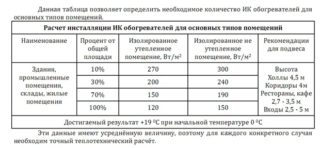 The construction installation process consists of several stages: preparation and installation itself. To mount the heater on the wall, you will need a standard set of tools: drill, screwdriver, pliers, fasteners, tape measure.
The construction installation process consists of several stages: preparation and installation itself. To mount the heater on the wall, you will need a standard set of tools: drill, screwdriver, pliers, fasteners, tape measure.
It is important to consider safety requirements.
When mounted on a wall, the heater can be parallel to it or at a slope. When installing, it is worth considering the following rules:
- Do not place the heater near fire hazardous objects.
- Do not allow the fasteners to touch the body of the appliance.
- For a residential building, structures over 800 watts will be inappropriate.
- It is best to position the heater opposite objects that absorb heat well: wood, aerated concrete, stone.
An important requirement for the location of electric energy-saving heaters for summer cottages is maintaining the distance to the person’s head. On average, it should be 1.5-2 meters. You can analyze the correct distance by the power of the equipment. If the indicator does not exceed 800 watts, 70 cm will be enough.
With the location of wall structures, they are repelled from the purpose of the room:
- bedroom - is located above the headboard;
- kitchen - placed on the wall opposite the window or door;
- bathroom - placed on a long wall, in extreme cases, on the ceiling to heat the entire room;
- hallway - on the wall with a slope to the floor next to the shoe storage area.
To ensure maximum heating of the room, it is recommended to install several heaters at once. However, they should have approximately the same power.

